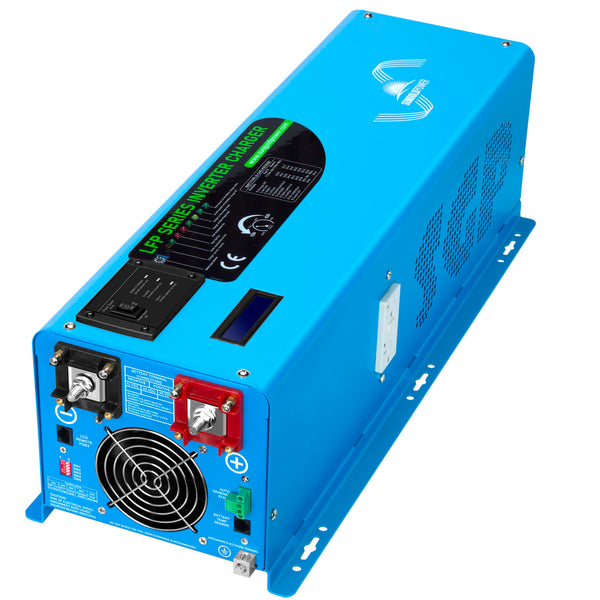lance
New Member
- Joined
- Jul 29, 2020
- Messages
- 168
It is a Kilovac.Which one do you have?
It is a Kilovac.Which one do you have?
i have the prior version of this inverter (Phoenix 1200va (non ve-direct). Also 12 volts. About 14 watts idle when the spec sheet says around 8 watts. But it will run my vacuum, which is impressive for its size.13W for an inverter rated for 8W is a pretty significant difference (only 5W over in absolute terms but that is like 60% over spec) I wonder if your measurement is representative of the smaller Phoenix inverters or an outlier.
(2) EG4 6500EX
Actual 84W and 85W while in battery mode.
Each, so 170W base load.
Great one-of-a-kind thread you've got going here! Idle power consumption is an often unspecified/non-reported figure that can be quite important and consequential, particularly with smaller systems. Here are the figures I measured from the inverter I'm currently using:In this thread, I hope to consolidate personal observations/measurements on inverter standby consumption. Specifically whether your observations are inline with what is stated on the datasheet, along with anything else you consider relevant, interesting, good or bad. With time--if this thread gains traction--it could be a useful resource for those shopping for inverters, and help us calibrate our expectations.
At a minimum report (1) Make+Model (2) Voltage (3) Max continuous power (4) Observed/measured standby consumption compared to spec sheet (5) Indicate whether power save features are active or not
Thank you for making this table and sharing it with us. I am quoting you to improve its visibility, as it was hard for me to find again. Perhaps this could be copied into the first post?
Inverter Idle Powers
Inverters Dynamote,Brutus,120V,3,200W,88.0W,36 MPP Solar,lvx6048 (AIO),120/240V,6,000W,140.0W,No,42 EG4,3000ehv,12V,3,000W,68.9W,43 Growatt,SPF 3000TL LVM-24P,12V,120V,3,000W,58.0W,Yes,11.5W,51 Easun,Phoenix VE.Direct,24V,230V,1,000W,20W,18.4W,54 Exeltech,XP 1100-124,24V,120V,1,100W,20W,20.0W,5...docs.google.com
Reliable QZRELB or whatever they call it. White case 12V 2000W 11 watts
I think it’s a fantastic piece of equipment for a lower-tier product. After much more use I’d say it’s 18W idle fwiw.I've had my eye on one , what do you think of it?
I think it’s a fantastic piece of equipment for a lower-tier product. After much more use I’d say it’s 18W idle fwiw.
It reliably turned off when a ‘bleeping cheap galldarned SCC’ pumped everything to 14.9V the other day.
It starts my skillsaw, handles a coffeemaker, runs a fridge 24/7, and the fans cycle acceptably.
I had to change the polarity on the outlets because N and H are connected backwards. I may not be able to N-G bond it but I’m going to try…
If it blows up I’m buying a 3000W Giandel pure sine inverter. Can be externally bonded, and I’ve been wanting to try 3000W at 12V anyway. 2000W is plenty.
Even though I took the time to correct the polarity on the outlets I’m using 10ga from it to the breaker panel.
I’m not sure but it’s not much… victron 3000 multi… no load , except the inverter/ dongle / shunt , if applicable..!In this thread, I hope to consolidate personal observations/measurements on inverter standby consumption. Specifically whether your observations are inline with what is stated on the datasheet, along with anything else you consider relevant, interesting, good or bad. With time--if this thread gains traction--it could be a useful resource for those shopping for inverters, and help us calibrate our expectations.
At a minimum report (1) Make+Model (2) Voltage (3) Max continuous power (4) Observed/measured standby consumption compared to spec sheet (5) Indicate whether power save features are active or not
*Keep in mind, any individual datapoint (even when its your own experience) is just a datapoint, subject to measurement error, bias, etc, but with a handful of datapoints, we can begin to feel a bit more confident drawing conclusions/generalizations.
I’m not sure but it’s not much… victron 3000 multi… no load , except the inverter/ dongle / shunt , if applicable..!
phone app says 31 watts …….I think there is a power saver on the multi it but it’s not on as I have never tried it.
im happy either way.
I'm genuinely curious why the EG4 Models pull so much more at idle. The original 2x MPP LV6548's that I had were at a rock solid 62w each, with a rated idle of 65w.(2) EG4 6500EX
Actual 84W and 85W while in battery mode.
Well one more time you point in the right direction for knowledge… … thanks , one day I owe you a Romulan pizza… tradition requires it can only be consumed along with Romulan ale ..the power saver is only usable if you have NO need of AC power... for clocks or fridge thermostats or anything like that. If you have ANYTHING using AC power constantly, power saving modes cannot be used.
i have the prior version of this inverter (Phoenix 1200va (non ve-direct). Also 12 volts. About 14 watts idle when the spec sheet says around 8 watts. But it will run my vacuum, which is impressive for its size.



